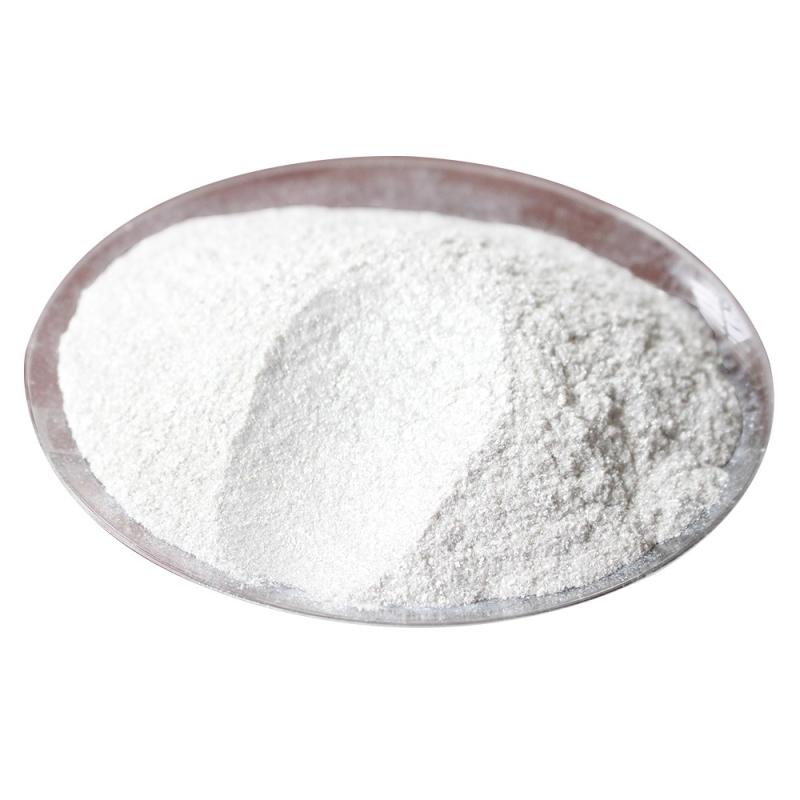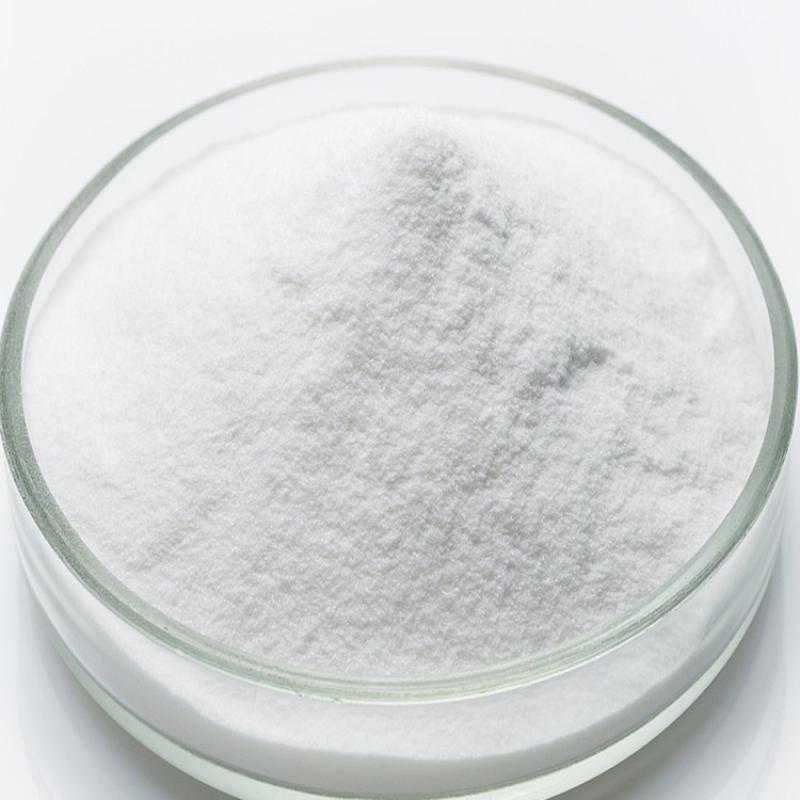Common name: PymetrozineChemical name: (E)-4,5-Fihydro-6-methyl-4-((3-pyridinylmethylene)amino)-1,2,4-triazin-3(2H)-oneMolecular formula: C10H11N5OStructural formula:Molecular weight: 217.23CAS No. : 123312-89-0Product description:Pymetrozine belongs to the pyridine (pyridinethimide) or triazinone class of insecticides and is a non - cytocytic insecticide. Pymetrozine has a tactile effect on insect pests and internal absorption activity. In plants, it can transport in both xylem and phloem. Therefore, it can be used as foliar spray and soil treatment.
Contacta ahora
Product Description:Pymetrozine is a non - cellular insecticide belonging to pyridinethimide or triazinone pesticide. Pymetrozine has tactile and endogenic activity to pests. In vegetation, it may be transported in every xylem and phloem. Therefore, it can be used as a foliar spray and soil remediation agent. Due to its correct transfer properties, newly grown branches can also be effectively covered after spraying stems and leaves.Common name: PymetrozineChemical name: (E)-4,5-Fihydro-6-methyl-4-((3-pyridinylmethylene)amino)-1,2,4-triazin-3(2H)-oneMolecular form
Contacta ahora
usage:Amide selective, pre-emergence herbicide, can be applied to corn, cotton, soybean, peanut, rape, potato, sugarcane, sesame, sunflower and legume, cruciferous, nightshade, compositae, umbelliferae, etc. Control annual grass weeds in vegetable fields and orchards, and a single application keeps crops free from weed damage throughout the growing period. Not effective against perennial weeds.Common name: AcetochlorChemical name: 2-chloro-N-(ethoxymethyl)-N-(2-ethyl-6-methylphenyl)acetamideMolecular formula: C14H20ClNO2Structural formula:Molecular weight: 269.77CAS No.
Contacta ahora
Common name: MCPAChemical name: (4-chloro-2-methylphenoxy)acetic acidMolecular formula: C9H9ClO3Structural formula: Molecular weight: 200.62CAS No. : 94-74-6Physical and chemical properties:The pure product is a white crystalline solid. m.p.118~119℃(120℃), solubility: ether 77g/100mL, ethanol 153g/100mL, n-hexane 0.5g/100mL, toluene 6.2g/100mL, xylene 4.9g/100mL, water 0.0825g/100mL. Industrial products m.p.99~107℃, smell of phenol.Usage:Hormone-based selective herbicides are easily absorbed and conducted by roots and leaves.
Contacta ahora
Product description:Propolachlor, also referred to as saufort, is mainly used for directly sown rice fields. it has the traits of secure rice boom, extensive weed control spectrum and proper weed manage impact. it could essentially manipulate the damage of weeds in the whole boom length.
Contacta ahora
Product description:Lufenuron is the active factor inside the veterinary flea manage remedy application, and one of the energetic elements in the flea, heartworm, ringworm and anthelmintic medicine milbemycin oxime/lufenuron (sentinel).Lufenuron is stored within the animal's body fats and transferred to adult fleas via the host's blood when they feed. adult fleas switch it to their growing eggs via their blood, and to hatched larvae feeding on their excrement.
Contacta ahora
Common name: ImazethapyrMolecular formula: C15H19N3O3Structural formula:Molecular weight: 289.33CAS No. : 81335-77-5Product description:Imazethapyr is a kind of organic heterocyclic herbicide, which belongs to imidazolinone compound, also known as Prosad, Imidazolium, Mizuoxazole, Prosthet, and Imazethapyr. Its isopropylamine salt is suitable for all weeds. It has excellent herbicidal activity against Cyperaceae weeds, annual and perennial monocotyledonous weeds, broad-leaved weeds and weeds.
Contacta ahora
Common name: GlufosinateChemical name: 2-Amino-4-[hydroxy(methylphosphonoyl)]butanoic acidMolecular formula: C5H18N3O4PStructural formula:Molecular weight: 215.19CAS No. : 77182-82-2Product description:Glufosinate-ammonium, also known as glufosinate, is a non-selective foliar spray of organophosphorus herbicide. It was first synthesized and developed by the Federal German Hoechst Chemical Company in 1979.
Contacta ahora
Common name: TriclopyrChemical name: [(3,5,6-trichloropyridin-2-yl)oxy]acetic acidMolecular formula: C7H4Cl3NO3Structural formula:Molecular weight: 256.47CAS No. : 55335-06-3Physical and chemical properties:The pure product is a white crystalline solid. m.p.148~150℃, decomposition temperature 290℃. The vapor pressure is 1.68×10-4Pa. It is soluble in organic solvents such as ethanol, and its solubility in water at 25°C is 430~440mg/L.
Contacta ahora
Chemical formula: C6H12N2S4Molecular weight: 240.433CAS no. : 137-26-8 Chemical properties:Pure product is colorless crystal, no smell. M.p. 155 ~ 156℃, relative density 1.29. Easily soluble in benzene, chloroform (230g/L), acetone (80g/L, Chemicalbook carbon disulphide and other organic solvents, slightly soluble in ether and ethanol (& LT; 10g/L), insoluble in water (30mg/L). It breaks down in acid. Industrial product is white or light yellow powder, M.P.
Contacta ahora
Usage:Chlorpyrifos is used in approximately one hundred nations round the world to manipulate insects in agricultural, residential, and business settings. its use in residential packages is limited in more than one international locations. in step with dow, chlorpyrifos is registered for use in nearly one hundred nations and is yearly carried out to approximately eight.five million crop acres. the crops with the maximum use consist of cotton, corn, almonds, and fruit trees, consisting of oranges, bananas, and apples.
Contacta ahora
Common name: 2,4-DChemical name:2,4-dichlorophenoxy-acetic acid; (2,4-dichlorophenoxy)acetic acid; Acetic acid, 2-(2,4-dichlorophenoxy)-Molecular formula: C8H6Cl2O3Structural formula: Molecular weight: 221.04CAS No. : 94-75-7Physical and chemical properties:White crystals. Melting point is 138°C, boiling point is 160°C (53Pa). Soluble in organic solvents such as ethanol, acetone, ether and benzene, but insoluble in water. Rat oral LD50375mg/kg.Usage:Used as plant growth regulator, antiseptic and fresh-keeping agent. It can be used in compatibility with other disinfectants.
Contacta ahora
Common name: CLOPYRALIDChemical name: 3,6-dichloropyridine-2-carboxylic acidMolecular formula: C6H3Cl2NO2Structural formula: Molecular weight: 192CAS No. : 1702-17-6Product description:Clopyralid is a systemic phytohormone-type herbicide, which is a product of Dow Company in the United States. It has good herbicidal effects and strong selectivity. Entered the U.S. market in 1987 to control annual or perennial broad-leaved weeds in corn and sugar beet fields.
Contacta ahora
Common name: SimazineChemical name:6-chloro-N,N’-diethyl-1,3,5-triazine-2,4-diamine; 6-chloro-N2,N4-diethyl-1,3,5-triazine-2,4-diamine; 2,4-Bis(ethylamino)-6-chloro-1,3,5-triazineMolecular formula: C7H12ClN5Structural formula:Molecular weight: 201.66CAS No. : 122-34-9 Physical and chemical properties:The pure product is white crystals. m.p.226~227℃, vapor pressure 8.13×10-7Pa(20℃). The solubility in methanol is 400mg/L, the solubility in water is 5mg/L, the solubility of in petroleum ether is 2mg/L, and it is slightly soluble in chloroform.
Contacta ahora
Chlorfenapyr is converted into active substances (insecticidal interest) by multifunctional oxidases in bugs. note: multifunctional oxidase mainly performs an critical role inside the interpretation of pyrethroids, organophosphorus and macrolides.Common name: CHLORFENAPYRChemical name: 4-bromo-2-(4-chlorophenyl)-1-ethoxymethyl-5-trifluoromethylpyrrole-3-carbonitrile Molecular formula: C15H11BrClF3N2OStructural formula:Molecular weight: 407.61CAS No. : 122453-73-0Physical and chemical properties:Pure white solid. M.p.
Contacta ahora
Usage:Azoxystrobin is a xylem-cellular systemic fungicide with translaminar, protectant and healing homes. in cereal crops, its fundamental outlet, the duration of ailment control is normally approximately 4 to 6 weeks all through the period of energetic stem elongation. all insecticides are required to seek registration from suitable authorities within the country in which they may be used.
Contacta ahora
Common name: AlachlorChemical name: 2-chloro-N-(2,6-diethylphenyl)-N-(methoxymethyl)acetamide; Molecular formula: C14H20ClNO2Structural formula:Molecular weight: 269.77CAS No.
Contacta ahora
Product Description:Butachlor is an amide-based, conductive, selective pre-emergence herbicide, also known as noralachlor, machete, and alachlor. This product is a light yellow oily liquid with a slight aromatic odor. It is not easily soluble in water and easily soluble in various organic solvents. It has chemical stability under normal temperature, neutral and weak alkaline conditions. Its decomposition is accelerated under strong acid conditions and can be degraded in soil. Low toxicity to humans and animals, irritating to skin and eyes, and high toxicity to fish.
Contacta ahora
Common name: PretilachlorProduct description:Propolachlor, also known as Saufort, is mainly used in direct-seeded rice fields. Correctly mastering the method of use has the characteristics of safe growth of direct-seeded rice, broad weed-killing spectrum, and good weeding effect. It can basically control the damage of weeds throughout the growth period.
Contacta ahora
Molecular formula: C4H6N2S4ZnMolecular weight: 276.7802CAS:12122-67-7 Physical property :1. Properties: off-white powder, industrial products are light yellow powder, slightly rotten egg taste, strong moisture absorption.2. Melting point (℃) : decomposition3. Relative density (water =1) : 1.74 (20℃)4. Octanol/water partition coefficient: 1.35. Solubility: insoluble in water, dissolved in carbon disulfide, pyridine, insoluble in most organic solvents. Toxicity:1. Acute toxicityLD50: > 5200mg/kg (rat oral)LC50:1850mg/m3 (rat inhalation)2. No data on irritation3.
Contacta ahora
Common name: DimethomorphChemical name:(E,Z)4-[3-(4-chlorophenyl)-3-(3,4-dimethoxyphenyl)acryloyl] morpholineMolecular formula: C21H22ClNO4Structural formula:Molecular weight: 387.86CAS No. : 110488-70-5Product description:It is a special fungicide of the class of oomycetes. Its function is to destroy the formation of cell wall membrane. It has an effect on all stages of the life history of oomycetes. It is especially sensitive in the formation stage of sporangia stems and oospores, at very low concentrations. Down (<0.25μg/ml) is inhibited.
Contacta ahora
Product description:It is a unique fungicide of the elegance of oomycetes. its function is to spoil the formation of cellular wall membrane. it has an effect on all tiers of the existence history of oomycetes. it's far in particular sensitive in the formation stage of sporangia stems and oospores, at very low concentrations. down (<0.25μg/ml) is inhibited. no move-resistance to phenylamides.Common name: DimethomorphChemical name:(E,Z)4-[3-(4-chlorophenyl)-3-(3,4-dimethoxyphenyl)acryloyl] morpholineMolecular formula: C21H22ClNO4Structural formula:Molecular weight: 387.86CAS No.
Contacta ahora
Structural formula:· Molecular weight: 255.66· CAS No. : 105827-78-9Physical and chemical properties:Pure product is white crystal, M.P. 143.8℃ (A), 136.4℃ (B), vapor pressure 2×10-7Pa (20℃)Specifications:97%TC, 25%WP, 10%WP, 70%WP, 35%SC, 60%FCProduct description:Imidacloprid is a systemic insecticide belonging to a class of chemicals called the neonicotinoids which act on the central nervous system of insects. The chemical works by interfering with the transmission of stimuli in the insect nervous system.
Contacta ahora
MF: C4H8MnN2S4ZnMW: 332.71CAS: 8018-01-7Melting point of 192-194 ° CDensity of 1.92 g/cm3Vapor pressure, Negligible AT, 20 °CFlash point is 138 ° CStorage condition APPROX 4°CWater solubility 6-20 mgl-1 (20 °C)Product description:Pure mancozeb is white powder, industrial products are gray white or light yellow powder, with rotten egg taste.
Contacta ahora


































